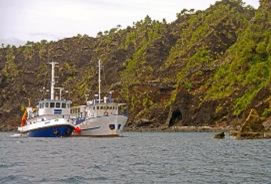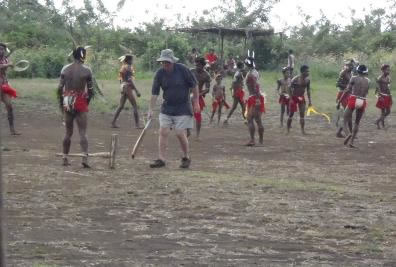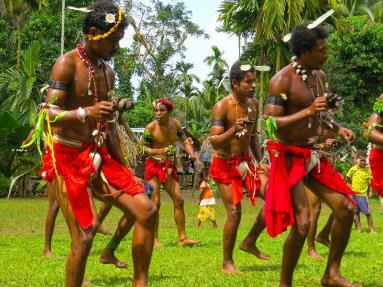Epic voyage 2013: Jacky Lawes
Jacqueline (“Jacky”) Lawes is a great granddaughter of the Reverend Dr William Lawes, of the London Missionary Society
 We were 32 passengers in all on two ships (the MV Miss Rankin and the Surveyor)1 with two captains (James and Tony Collins) and terrific local crew as we set out on a fabulous adventure cruise around PNG. This Epic Voyage lived up to its name and was the collaboration between The Collins Brothers and John Sinclair who previously ran Go Bush Safaris. The itinerary was based on their local knowledge of PNG and some particular passenger requests. Well known and well-loved naturalist Ian Morris was unable to attend at the last minute and Bruce Alexander stepped in as entrepreneur and story teller. Our adventure was richly informed by stories of those who had lived in PNG and by excellent local guides. With an average age of 65 we were an intrepid and fearless lot of ‘Epic-ers’! Where possible we visited schools and distributed much welcomed educational and sporting materials.
We were 32 passengers in all on two ships (the MV Miss Rankin and the Surveyor)1 with two captains (James and Tony Collins) and terrific local crew as we set out on a fabulous adventure cruise around PNG. This Epic Voyage lived up to its name and was the collaboration between The Collins Brothers and John Sinclair who previously ran Go Bush Safaris. The itinerary was based on their local knowledge of PNG and some particular passenger requests. Well known and well-loved naturalist Ian Morris was unable to attend at the last minute and Bruce Alexander stepped in as entrepreneur and story teller. Our adventure was richly informed by stories of those who had lived in PNG and by excellent local guides. With an average age of 65 we were an intrepid and fearless lot of ‘Epic-ers’! Where possible we visited schools and distributed much welcomed educational and sporting materials.
Our adventure began at Tabubil with a visit to the mist enshrouded Ok Tedi mine then on to Kiunga at the headwaters of the Fly River where we boarded our vessels Miss Rankin and Surveyor. At Kiunga we made a dawn trek into the rainforest to see and hear the Greater Birds of Paradise and later enjoyed our first of many sing sings. Heading off down the Fly we visited villages of Kukujaba, Kuatra and Sapuka and greatly enjoyed the wonderful birdlife and beauty of Suki Wetlands. We saw evidence of refugee settlements along the river. There was also evidence of degradation due to deforestation.
Reaching the mouth of the Fly we ventured into the Delta region and visited Aird Hill the home of Ben Butcher of the LMS (London Missionary Society) who went to replace James Chalmers also of LMS who had been massacred by head hunters. Particular interest in this visit was to locate and record the burial site of Phyllis Meuri Butcher, Butcher’s daughter who had died there aged 8, and we were successful in doing this. Aird Hill is a very beautiful place with the original house and early equipment still intact at the village of Arrow paying tribute to Butcher’s legacy. Also there was a well-weathered monument to James Chalmers.
After a very rough passage across the Gulf of Papua we arrived at Port Moresby which was a great contrast to where we had just been. Firstly we visited the Adventure and Nature Park and saw a wonderful array of birds and animals including the Reggiana Bird of Paradise, Lawes’ Parotia, Blyth’s Hornbill, tree kangaroos and many more. It also housed the National Orchid Collection which took our collective breath away.
The Bomana War Cemetery contains more than 3000 graves and is beautifully maintained. After our visit there we lunched at the Royal Papuan Yacht Club. We then visited the Museum and took a photo opportunity at Parliament House.

Jacky at monument
to WG Lawes
Then followed a highlight for me as we visited Hanuabada in search of the place where my great grandfather, WG Lawes,2 lived during his time in Port Moresby. He with his wife was the first L.M.S. missionary to live on a permanent basis in Papua (1874-1905). His closest friend and colleague was James Chalmers whose monument we had seen at Aird Hill. Ben Butcher reports in his autobiography, We Lived with the Headhunters, (1963) tells of meeting WG Lawes as he was leaving Papua for the last time.
We were welcomed by the local pastor and treasurer who showed us the monument on the site where WG’s house had once stood and it was moving to see how revered these missionaries and especially my great grandfather still are after all these years. The local Post-Courier appeared and reported our visit (28 May 2013). As result of this coverage, other related people of the church approached me with news that they were about to erect another memorial plaque for WG Lawes on the anniversary of his landing at Papaka, on 24 June 1876! There was also a monument to the South Seas Pastors and to Ruatoka the first local Papuan ordained minister.
At Happy Hour we were visited by Port Moresby friends and many hilarious tales and jokes were exchanged.
We left Port Moresby on a full moon evening and headed east into another rough crossing of the Coral Sea, stopping for respite snorkels off Wakauveli and Suau Islands on the way to Samarai. It was fascinating to see this once thriving port and capital of East Province and imagine its rich and elegant history. Its deterioration following the bombing by Allied Forces during the war, to prevent Japanese intrusion, was only too apparent. The old Anglican Church and the former Burns Philp building were in ruinous condition and the hospital on top of the hill had recently burned to the ground. But this decay was matched with rebuilding. The new hospital is on sea level and in good condition. The pastor beamed happily at us with his buai smile and the teachers amongst us were impressed with school and happily gave donations of books, paper, etc. Of interest also was a monument to Christopher Robinson, ‘Able Governor, Upright Judge’ whose goal was ‘To make New Guinea a good country for white men’!
From Samarai we cruised to the Trobriand Islands. The Deidei hot springs of Palagwau (East Fergusson Island) offered fabulous displays of colours, patterns and warm vapours. The vegetation en route and surrounds was rich and full of life: pitcher plants, dragon flies, birdwing butterflies and songs of manucodes. Kiriwina Island provided lots of action including a very hot walk from Kaibola village (transport did not arrive) to inspect megaliths suspected to be man-made remnants from a previous culture; sing-sing at Omarikama and Obweria villages then on to Buria Lodge Resort for lunch.

Don Hook batting at Trobriands cricket match*
The highlight of the trip for nearly everyone was the Trobriand Islands Cricket Match. This involved many Trobriand Islanders in traditional costume: it doesn’t matter how many on a side so long as each side has the same. The rules were unrecognisable except that sledging was encouraged with goal being that everyone has as much fun as possible!! Several ‘Epic-ers’ went in to bat but not for long! (Apparently the BBC made a famous documentary of the Trobriand Island Cricket Match many years ago.

Our final delight of the day at Bweka Village was a distinctly Polynesian flavoured singsing by beautiful Trobriand young men and women with accompanied by melodious guitars and singing of the villagers. Bweka is the home of Premier Chief John and the singsing was performed in a beautiful clearing surrounded by large shady trees
Leaving the Trobriands we headed for the Luscancay Island Group, then Tami Island finally anchoring off Ritter Island (Kulkul) a remnant volcano and source of great geological interest. We tried to climb a volcano and see megapodes on Long Island to no avail, but we compensated with a swim.
Heading west we avoided Vitiaz Strait, reached Madang and moored off the Madang Club. We were joined in Madang by James’ new family for lunch at the Country Club which added a nice personal touch. Bernie Leahy joined us for Happy Hour. We left Bruce in Madang to pursue his next job as deer and buffalo hunter.
Onward to the Sepik! We passed volcanic Manam Island early in the morning with its plumes of ash and smoke. It was a spectacular sight but not too threatening. There were many volcanic islands which provided a very picturesque outlook as we headed for the Sepik.
The opening to the Sepik was modest by comparison to the Fly: there was some muddy outflow and quite a small entrance. We thoroughly enjoyed being back on river cruising and bird spotting mode and stopped again at various villages along the way: Angoram, original village of Michael Somare; Kambaramba which was a really fascinating village of stilt houses: despite obvious flooding everyone was out to greet us on platforms of houses, in dugouts or sailing boats. It was a real spectacle for all to share.
Sadly the local school had been destroyed but found a replacement to give our usual donations to. Other Sepik villages of Tambanum, Kaminabit, Palembei and Kanganaman proffered rich opportunity for buying artefacts and sing-sings and at Palembei and Kanganaman we were invited into spirit houses, apparently a new innovation to cater for tourism. High water levels meant that we had to approach Palembei by banana boat and this was truly beautiful in the early morning light. On our return down the Sepik we also stopped at Marienberg a Catholic mission with a strong German history.
Once out of the Sepik we were again in rough waters so we headed straight for Wewak where we visited Cape Wom, the site of the Japanese surrender and the end of WWII.
Another fabulous adventure in a land which never ceases to amaze!
1. Miss Rankin is a 28m steel hulled multi-purpose small ship. There is accommodation for 32 people including crew. The Surveyor, also 28m, is designed as a survey, supply and research vessel and can carry 12 passengers.
2. Dr Lawes reached Port Moresby from Savage Island (now known as Niue) in November 1874.


